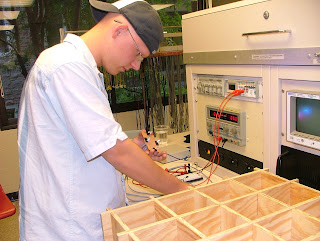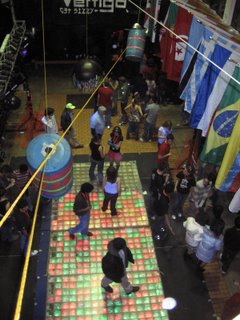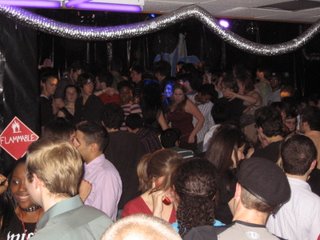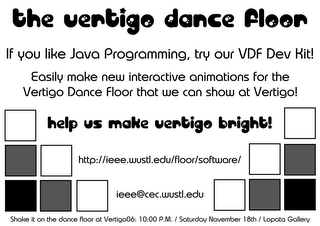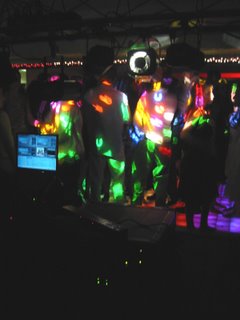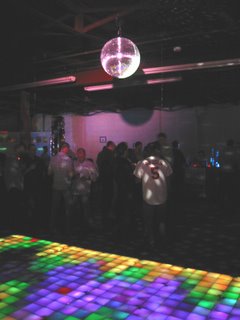We had our second meeting for the VDF2.0 this past Thursday. Due to the extremely small percentage of the world's population who showed up, I took notes on the meeting and will post them shortly. And by shortly, I mean immediately.
October 4, 2007 Meeting Summary:
This is a long summary, but it covers a lot of the design choices that we’ve made so far. I tried to keep it light hearted for your sake. If you read nothing else, read the conclusion. These summaries should be shorter in the future.
Electronics
In order to simplify the amount of cables needed for the new dance floor, the MIT circuit board used in the original dance floor will be chopped into two parts. One part will contain the LED drivers. This board has been dubbed the “mini-board” (sometimes denoted µ-board (please ignore the fact that µ means micro)).
Each mini-board will sit at the shared corner of the four cells that it controls. By controlling cells in this manner rather than MIT’s method of controlling full rows with a single board, we use a lot less cable to reach each cell. Grant has already begun a CAD design of these boards, and is continuing to work on it for next week’s meeting.
The second part we will harvest from our Frankensteining of the MIT board has been denoted the “mini-controller” (it hasn’t technically been referred to as µ-controller yet, but give it time). This board’s main function is to control the mini-board. It connects to the mini-board using an I²C connection. The I²C connection has four lines: data, clock, ground, and power. As of now, there are a few questions still floating around regarding this connection, such as: Will power affect data? Can the clock signal get onto the power wire? Should we ask a professor about this? A mysterious file known only as “Gerber 2.x” contains a lot of insight into the MIT board. Unfortunately, this file is currently being horded by MIT, so Corinne is going to ninja-sneak into their database and blindside them. Or maybe she’ll just ask them for it… Anyway, Grant is holding off on CAD-ing the mini-controller until he has gotten to look at the enigmatic Gerber file.
For next week, the Electrical folks are going to…
1) Update the proposal for the electronic aspect of the floor.
2) Work on a CAD design for the mini-board.
3) Ask professors about data/power.
4) Ninja-sneak information out of MIT.
Mechanical
The first mech-y design issue we talked about was the possibility of making the dance floor shallower. We discussed the pros (lighter, more portable, more stackable) and cons (need room for power?) of this change, but eventually decided that keeping the board at the same height as a standard staircase step would benefit the drunken buffoons who will be using the dance floor.
Another design issue was whether the individual cells should be smaller. They are currently 6 in X 6 in. We debated shrinking these down to 4 in X 4 in, but after noting that this would shrink the overall floor size too significantly this idea was scrapped.
One of the biggest problems that the new board faced was that the mini-boards needed to be on the top of the floor (where it would surely be crushed by the weight of the ignorant masses), or on the bottom (where it would surely be crushed by the weight of the ignorant masses plus the weight of the floor itself). This led to Richard’s invention of what is being called “the basement”. The basement is a 2 inch high compartment which will house all the wires, boards, and USB hubs for the dance floor. The basement is a perfect name for this compartment because, like a real basement, it’s the bottom level, it’s going to be a messy hodgepodge of electronics, and it’s where the hot water heater is going to be.
In order to maximize the diffusion of the LED’s, Ben proposed running ribbon wire from the board up to a crimping connector thingy that will house the LED’s. This will dramatically reduce the number of late night soldering parties, but IEEE members didn’t seem to mind.
Construction
The board itself will be made out of acrylic. This design has a number of advantages:
1) Lighter
2) Cooler looking
3) Easier construction, since Richard knows a guy who can laser cut the plastic into the right sizes.
The floor is going to be made out of smaller chunks than the last one. 4 cell by 4 cell blocks with approximately 25 inch sides will come together to form the standard 16 by 8 cell floor that everyone has come to know and love. Some of Richard’s assignments for next week include: coming up with a finished design for the floor and doing a cost analysis of the materials.
Software
By changing over from one board controlling a full row to one board controlling a quadrant of cells, the programs that people wrote for the first dance floor will no longer display properly. This is where the software team will need step in. Programming the dance floor based on a row-column idea is a very straight forward way to do it, and since programs have already been written following this paradigm, the most logical solution for the new dance floor is to change the way the cells are addressed. This will allow us to still use the old programs and to continue writing in a common sense style. Any questions regarding how the cells are addressed can be directed at Pehr and/or Garrett.
Conclusion
For next week’s meeting, everyone should read MIT’s DDF 2.0 documentation. I believe that Corinne is going to send out an email with it attached as a PDF. Otherwise, Google that mutha. If you need any more information about any given topic in this summary, send me an email at jtp2 at ye olde cec.wustl.edu
Future posts will have pretty pictures and a lot less boring introductory definitions, so don't get discouraged by the length of this post.
Labels: meeting, october 4, summary


